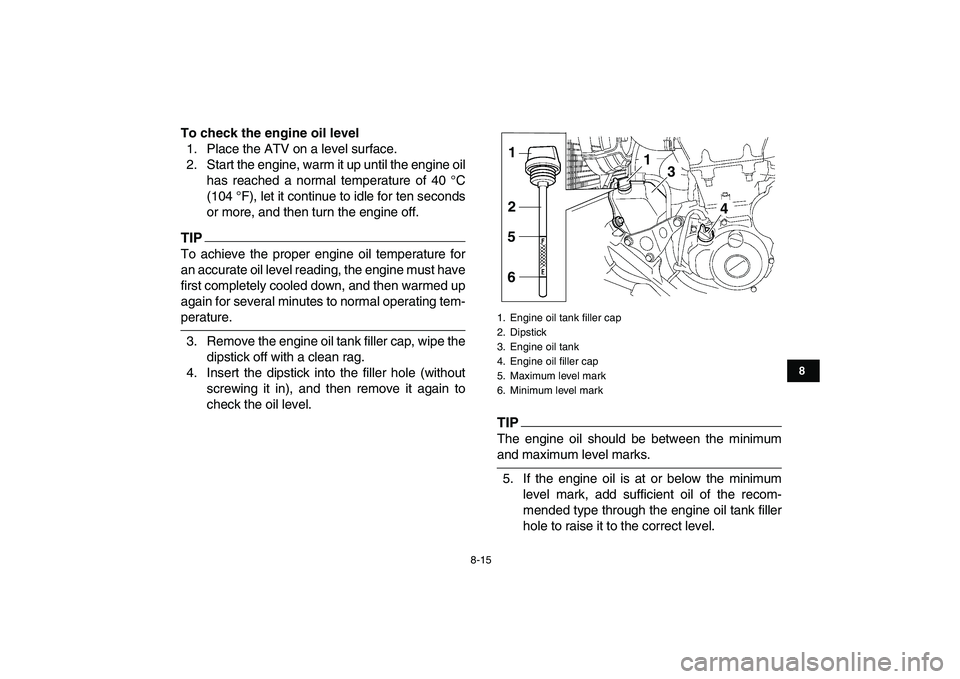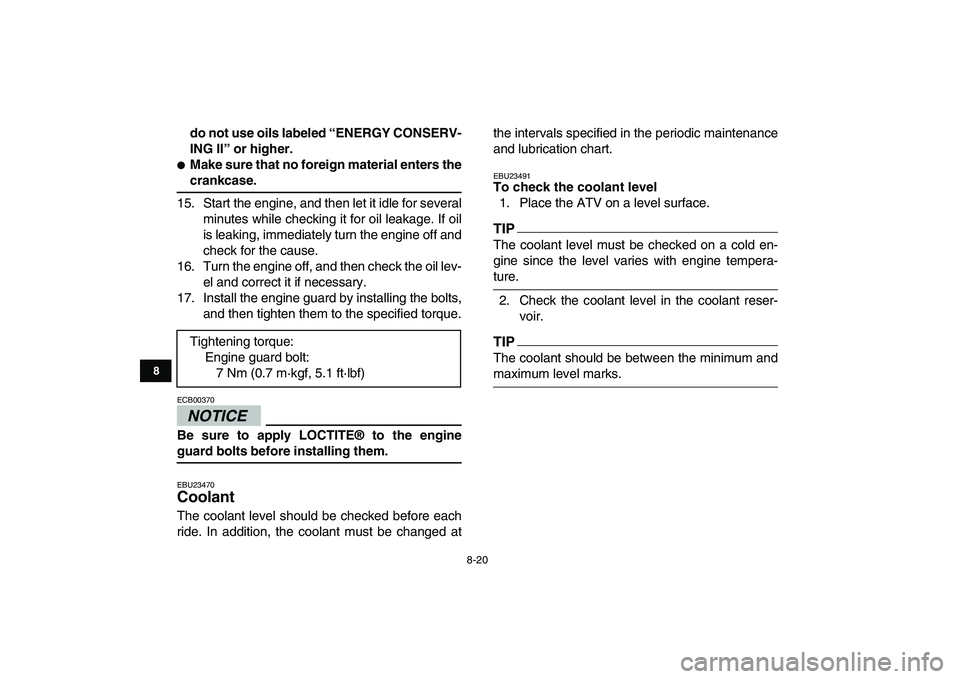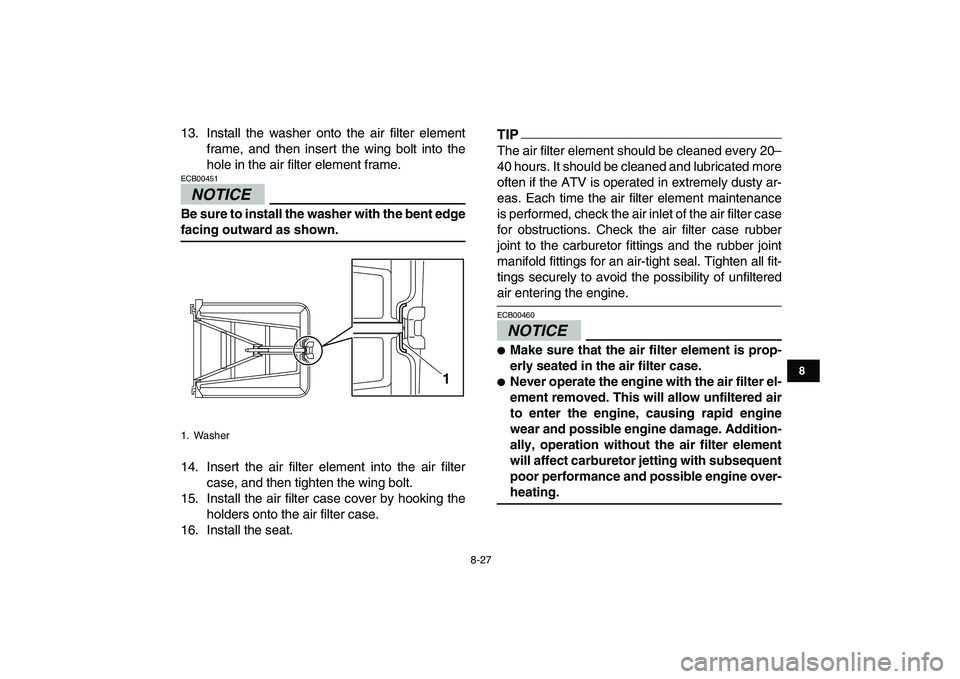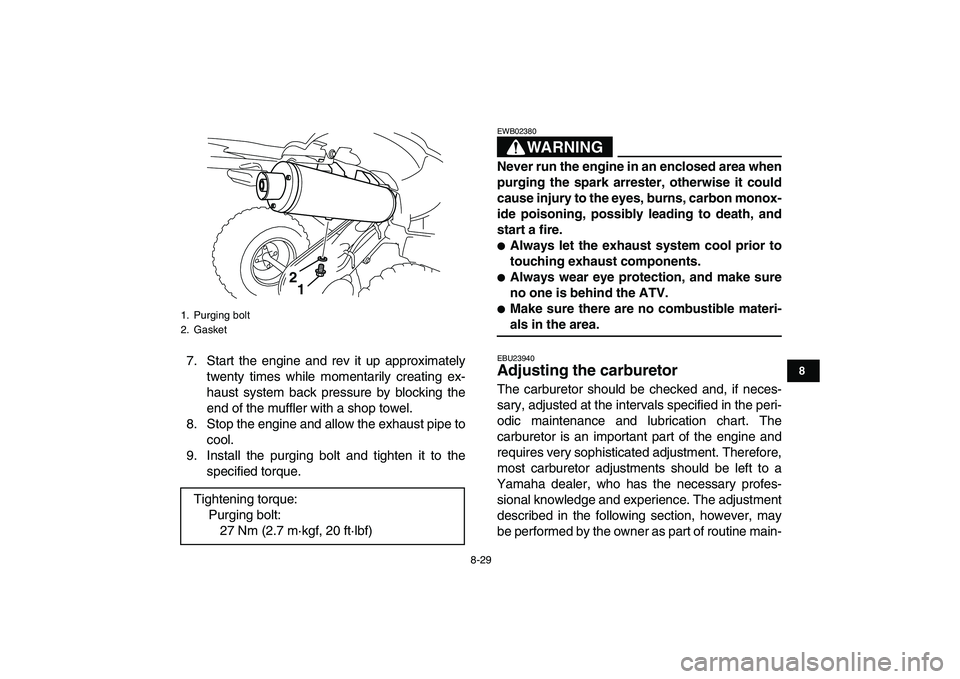Page 95 of 150

8-15
1
2
3
4
5
6
78
9
10
11
To check the engine oil level
1. Place the ATV on a level surface.
2. Start the engine, warm it up until the engine oil
has reached a normal temperature of 40 °C
(104 °F), let it continue to idle for ten seconds
or more, and then turn the engine off.
TIP
To achieve the proper engine oil temperature for
an accurate oil level reading, the engine must have
first completely cooled down, and then warmed up
again for several minutes to normal operating tem-
perature.
3. Remove the engine oil tank filler cap, wipe the
dipstick off with a clean rag.
4. Insert the dipstick into the filler hole (without
screwing it in), and then remove it again to
check the oil level.
TIP
The engine oil should be between the minimum
and maximum level marks.
5. If the engine oil is at or below the minimum
level mark, add sufficient oil of the recom-
mended type through the engine oil tank filler
hole to raise it to the correct level.
1. Engine oil tank filler cap
2. Dipstick
3. Engine oil tank
4. Engine oil filler cap
5. Maximum level mark
6. Minimum level mark
4 3 1 1
2
5
6
Page 97 of 150
8-17
1
2
3
4
5
6
78
9
10
11
6. Remove the engine oil tank filler cap and the
engine oil tank drain bolt.7. Check the washers for damage, and replace if
necessary.
TIP
Skip steps 8–11 if the oil filter element is not being
replaced.
8. Remove the oil filter element cover by remov-
ing the bolts, and then remove the oil filter el-
ement.
1. Crankcase engine oil drain bolt
1
1. Engine oil tank drain bolt
1
Page 100 of 150

8-20
1
2
3
4
5
6
78
9
10
11
do not use oils labeled “ENERGY CONSERV-
ING II” or higher.
�
Make sure that no foreign material enters the
crankcase.
15. Start the engine, and then let it idle for several
minutes while checking it for oil leakage. If oil
is leaking, immediately turn the engine off and
check for the cause.
16. Turn the engine off, and then check the oil lev-
el and correct it if necessary.
17. Install the engine guard by installing the bolts,
and then tighten them to the specified torque.
NOTICE
ECB00370
Be sure to apply LOCTITE® to the engine
guard bolts before installing them.
EBU23470
Coolant
The coolant level should be checked before each
ride. In addition, the coolant must be changed atthe intervals specified in the periodic maintenance
and lubrication chart.
EBU23491
To check the coolant level
1. Place the ATV on a level surface.
TIP
The coolant level must be checked on a cold en-
gine since the level varies with engine tempera-
ture.
2. Check the coolant level in the coolant reser-
voir.
TIP
The coolant should be between the minimum and
maximum level marks. Tightening torque:
Engine guard bolt:
7 Nm (0.7 m·kgf, 5.1 ft·lbf)
Page 101 of 150

8-21
1
2
3
4
5
6
78
9
10
11
3. If the coolant is at or below the minimum level
mark, remove panel A. (See page 8-9.)
4. Remove the reservoir cap, add coolant or dis-
tilled water to the maximum level mark, install
the reservoir cap, and then install the panel.NOTICE
ECB00401
�
If coolant is not available, use distilled water
or soft tap water instead. Do not use hard wa-
ter or salt water since it is harmful to the en-
gine.
�
If water has been used instead of coolant, re-
place it with coolant as soon as possible,
otherwise the cooling system will not be pro-
tected against frost and corrosion.
�
If water has been added to the coolant, have
a Yamaha dealer check the antifreeze con-
tent of the coolant as soon as possible, oth-
erwise the effectiveness of the coolant will
be reduced.
TIP
If the engine overheats, see page 8-55 for further
instructions.
EBU23561
To change the coolant
WARNING
EWB01890
Wait for the engine and radiator to cool before
removing the radiator cap. You could be
1. Maximum level mark
2. Minimum level mark
3. Coolant reservoir
4. Coolant reservoir cap
Coolant reservoir capacity (up to the maximum
level mark):
0.29 L (0.31 US qt, 0.26 Imp.qt)
1
24
3
Page 104 of 150

8-24
1
2
3
4
5
6
78
9
10
11
otherwise the cooling system will not be pro-
tected against frost and corrosion.
�
If water has been added to the coolant, have
a Yamaha dealer check the antifreeze con-
tent of the coolant as soon as possible, oth-
erwise the effectiveness of the coolant will
be reduced.
12. Install the radiator cap, start the engine, let it
idle for several minutes, and then turn it off.
13. Remove the radiator cap to check the coolant
level in the radiator. If it is low, add sufficient
coolant until it reaches the top of the radiator,
and then install the radiator cap.
14. Start the engine, and then check for coolant
leakage.
TIP
If any leakage is found, have a Yamaha dealer
check the cooling system.
15. Install the panel.
EBU23703
Cleaning the air filter element
The air filter element should be cleaned at the in-
tervals specified in the periodic maintenance and
lubrication chart. Clean the air filter element morefrequently if you are riding in unusually wet or dusty
areas.
TIP
There is a check hose at the bottom of the air filter
case. If dust or water collects in this hose, empty
the hose and clean the air filter element and air fil-
ter case.
1. Place the ATV on a level surface.
2. Remove the seat. (See page 4-11.)
3. Remove the air filter case cover by unhooking
the holders.
1. Air filter case check hose
1
Page 106 of 150
8-26
1
2
3
4
5
6
78
9
10
11
8. Wash the sponge material gently but thor-
oughly in solvent.
WARNING
EWB01940
Always use parts cleaning solvent to clean the
sponge material. Never use low-flash-point
solvents or gasoline to clean the sponge mate-
rial because the engine could catch fire or ex-
plode.
9. Squeeze the excess solvent out of the sponge
material and let it dry.
NOTICE
ECB00440
Do not twist the sponge material when squeez-
ing it.
10. Check the sponge material and replace it if
damaged.
11. Apply a quality foam air filter oil to the sponge
material.
TIP
The sponge material should be wet but not drip-
ping.
12. Pull the sponge material over the air filter ele-
ment frame.
1. Sponge material
2. Air filter element frame
1 2
Page 107 of 150

8-27
1
2
3
4
5
6
78
9
10
11
13. Install the washer onto the air filter element
frame, and then insert the wing bolt into the
hole in the air filter element frame.
NOTICE
ECB00451
Be sure to install the washer with the bent edge
facing outward as shown.
14. Insert the air filter element into the air filter
case, and then tighten the wing bolt.
15. Install the air filter case cover by hooking the
holders onto the air filter case.
16. Install the seat.
TIP
The air filter element should be cleaned every 20–
40 hours. It should be cleaned and lubricated more
often if the ATV is operated in extremely dusty ar-
eas. Each time the air filter element maintenance
is performed, check the air inlet of the air filter case
for obstructions. Check the air filter case rubber
joint to the carburetor fittings and the rubber joint
manifold fittings for an air-tight seal. Tighten all fit-
tings securely to avoid the possibility of unfiltered
air entering the engine.
NOTICE
ECB00460
�
Make sure that the air filter element is prop-
erly seated in the air filter case.
�
Never operate the engine with the air filter el-
ement removed. This will allow unfiltered air
to enter the engine, causing rapid engine
wear and possible engine damage. Addition-
ally, operation without the air filter element
will affect carburetor jetting with subsequent
poor performance and possible engine over-
heating.
1. Washer
1
Page 109 of 150

8-29
1
2
3
4
5
6
78
9
10
11
7. Start the engine and rev it up approximately
twenty times while momentarily creating ex-
haust system back pressure by blocking the
end of the muffler with a shop towel.
8. Stop the engine and allow the exhaust pipe to
cool.
9. Install the purging bolt and tighten it to the
specified torque.WARNING
EWB02380
Never run the engine in an enclosed area when
purging the spark arrester, otherwise it could
cause injury to the eyes, burns, carbon monox-
ide poisoning, possibly leading to death, and
start a fire.
�
Always let the exhaust system cool prior to
touching exhaust components.
�
Always wear eye protection, and make sure
no one is behind the ATV.
�
Make sure there are no combustible materi-
als in the area.
EBU23940
Adjusting the carburetor
The carburetor should be checked and, if neces-
sary, adjusted at the intervals specified in the peri-
odic maintenance and lubrication chart. The
carburetor is an important part of the engine and
requires very sophisticated adjustment. Therefore,
most carburetor adjustments should be left to a
Yamaha dealer, who has the necessary profes-
sional knowledge and experience. The adjustment
described in the following section, however, may
be performed by the owner as part of routine main-
1. Purging bolt
2. Gasket
Tightening torque:
Purging bolt:
27 Nm (2.7 m·kgf, 20 ft·lbf)
1 2